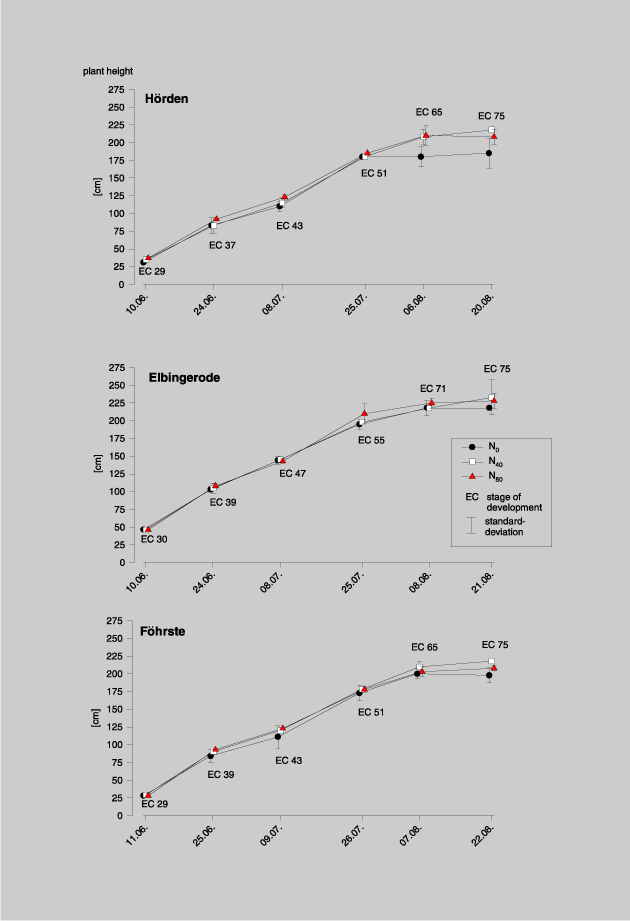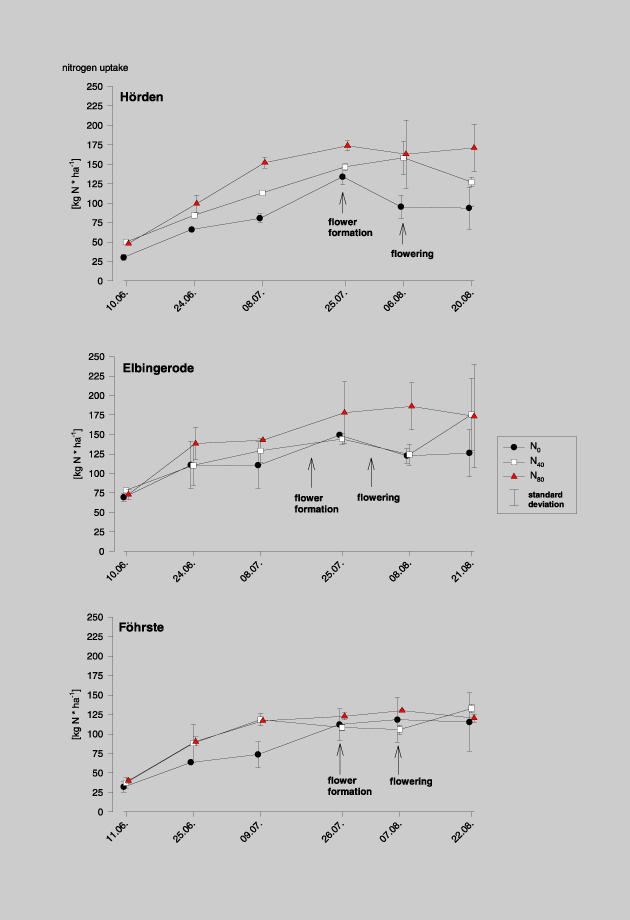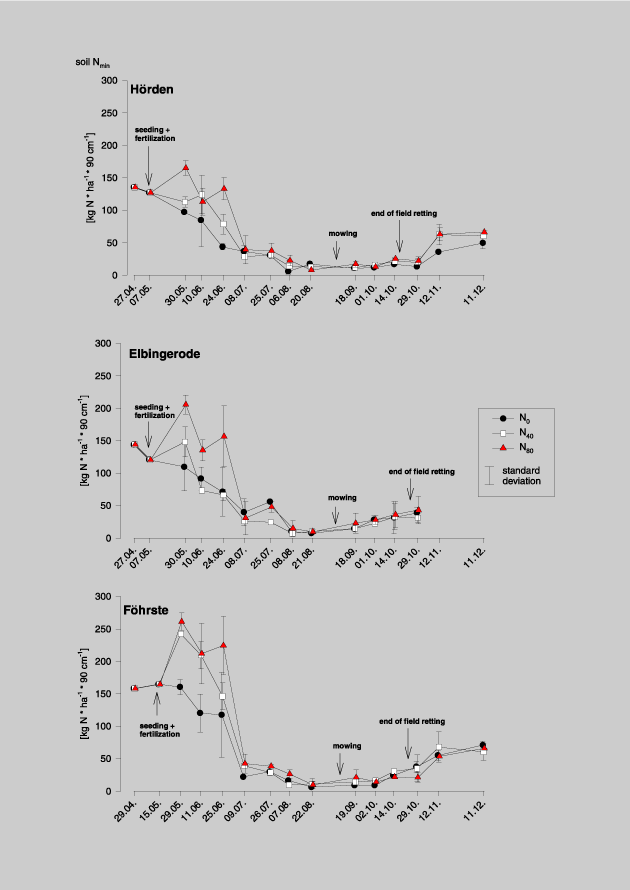
24
Hemp: a ground water protecting crop?
Yields and nitrogen dynamics in plant and soil
Katja Hendrischke1, Thomas Lickfett1, and Hans-Bernhard von Buttlar2,3
1Georg-August-University, Institute for Agricultural Chemistry, Von-Siebold-Str.
6, D-37075 Goettingen, Germany
2Ingenieurgemeinschaft Landwirtschaft und Umwelt (IGLU), Buehlstr. 10,
D-37073 Goettingen, Germany
3University of Kassel, Institute of Crop Science, Steinstr. 19, D-37213
Witzenhausen, Germany
Hendrischke, Katja, Thomas
Lickfett and Hans-Bernhard von Buttlar 1998. Hemp: a ground water protecting
crop? Yields and nitrogen dynamics in plant and soil. Journal of the
International Hemp Association 5(1): 24-28. The aim of this work was to
examine the yields and nitrogen (N) dynamics of plant and soil in fiber hemp
production, as affected by N fertilization and with special regard to the
suitability of hemp cultivation in water catchments. Field experiments were laid
out in 1996, cropping fiber hemp at three different levels of nitrogen
fertilization and followed by field retting. Plant height, plant density, dry
matter production, and nitrogen content in above-ground plant material and crop
residues were determined. Additionally, soil Nmin (0 - 90 cm) under the growing
crop and after the harvest was recorded.
Results indicate that both the soil
parameters (soil fertility) and the seeding technique influence crop development
and yield. Under conditions of high amounts of soil N min at the beginning of
the experiment, applied nitrogen fertilizer showed no significant effect on dry
matter yield. At harvest, almost no Nmin was left in the soil. Nitrogen net
mineralization of soil organic matter and plant residues increased after mowing
and during the retting period, until December. This led to enhanced Nmin status
of soil after the vegetation period. This nitrate can be liable to leaching into
ground water with the precipitation that occurs during winter and the following
spring season. Hence, growing fiber hemp with field retting in water catchments
might cause problems concerning nitrate content of water wells.
Introduction
Hemp is regarded as a
plant providing bioresources (oil and fiber) of high quality with
environmentally compatible cultivation properties (e.g. renunciation of
pesticides). In Germany, hemp cropping was excluded from the discussion on
sustainable production of non-food-crops due to the prohibition of hemp
cultivation which has existed since 1982. After repealing this prohibition in
Spring 1996, a considerable deficiency of knowledge about hemp cultivation in
Germany under contemporary conditions soon became evident. From the agricultural
point of view, both the effect of nitrogen fertilizers on crop yield and the
ecological consequences of its use in hemp cultivation is of particular
interest. The use of nitrogen on plants and the dynamic and mobility of nitrogen
in the soil are of special importance in regards to environmentally safe hemp
production in order to avoid ground water pollution with nitrate. For this
reason, in 1996, field experiments on hemp cultivation in Lower Saxony were
carried out to answer the following questions:
Materials and methods
From April to December 1996, field experiments with fiber hemp (no seed harvesting) and a subsequent
field retting were performed at four locations of southern Lower Saxony, Germany (Foehrste I + II, Elbingerode and
Hoerden). The experimental fields in Foehrste were cultivated under a minimum tillage technique. The French
monoecious variety Fedora 19 was sown in May with a seeding rate of 49-56 kg/ha to achieve a plant density of
300 plants m2 . The experimental set-up was a large scale plot consisting of three nitrogen fertilization levels (0, 40,
80 kg N/ha, respectively, pre-emergence dressing) with one replication. During the vegetation period, the stage of
development, plant height, plant density, fresh and dry weight of the plants and nitrogen content in above-ground
dry matter were recorded six times. The area harvested was two m2 each. The stage of development was described
with EC numbers following a proposal of Von Buttlar et al. (1997). After mowing in September, the plants were
left in the field for a six week dew retting period. Soil sampling for measuring
Nmin (CaCl2 soluble nitrate and ammonia) took place every two weeks for the duration of
the entire field experiment. Nt in oven-dried plant material was determined by thermal conductivity following dry
combustion (DUMAS). In addition to the field experiment, the six week field retting period was
simulated in an open greenhouse to quantify and qualify the alteration of the harvested crops.

Development and plant height of hemp crops at three levels of N fertilization.Figure 1.
Results and discussion
Development of hemp crops-
At the experimental site in Foehrste I,
hemp plants were already suppressed by weeds six weeks after seeding. Problems in
seed bed preparation are considered to be the main reason for the stunted hemp; direct
drilling in the mulch of the pre-crop set-aside seemed to restrict optimum growth of hemp
plants shortly after emergence. For these reasons, the experiment at this site was
canceled.
At the experimental sites in
Elbingerode, Hoerden and Foehrste II, crop development was almost uniform. Plants in
Elbingerode were slightly ahead in early growth. The main elongation phase (EC 29)
began after six weeks (Figure 1). Within 45 days after emergence, the hemp plants grew to
1.5 m, which corresponds to a daily growth rate of 3.3 cm. After 88 days of vegetative
phase, the hemp crops reached the generative phase (EC 51). Grain ripening (EC 75)
occurred 118 days after sowing.
Nitrogen fertilization did not
significantly affect plant height throughout the entire vegetation period (Figure 1). Results of the
field experiment confirm that plant height is essentially influenced by location ("soil
fertility") and duration of the vegetative phase (Höppner and Menge-Hartmann 1994). The
plot mean at Elbingerode showed significantly taller plants at final harvest (226 cm) than the
other sites, with a plot mean of 212 cm. The continuing increase in plant height after flower
formation can be explained by a lengthening of the inflorescences (Bócsa and Karus 1997).
Dry matter yield-
Averaging the three levels of nitrogen
fertilization, above-ground dry matter yields were 13.5 t/ha in Elbingerode, 10.9 t/ha in
Hoerden and 10.2 t/ha in Foehrste, respectively. The differentiation is assumed to be due to soil fertility
and duration of the vegetative phase, which was one week shorter in Foehrste due to a later seeding date. There was no
significant effect of nitrogen fertilization on dry matter yield at final harvest (plot mean). High amounts of soil
Nmin at the beginning of the experiment (150 kg N/ha at 90 cm) may be an explanation for the lack of a distinct
improvement of crop yield caused by an enhanced nitrogen dressing, as described by van der Werf (1994). At final
harvest before the retting period, mean dry matter yield was 11.5 t/ha (three sites) which is equivalent to approximately
40 t/ha of fresh matter with a dry matter content of 29%. French breeders of the variety ‘Fedora 19’ indicated yields
between 11.2 and 11.9 t/ha (FNPC 1994).

Nitrogen uptake of hemp (above ground plant material) during vegetation period at three levels of N fertilization.Figure 2.
Nitrogen uptake of hemp-
During the main elongation phase, nitrogen
absorption of the plants increased continuously. With the onset of flowering (EC 55) the increase of nitrogen
absorption stagnated (Figure 2).
Averaged over all nitrogen fertilizing levels at final
harvest, plants at Hoerden und Foehrste had absorbed 123 kg N/ha and 159 kg N/ha at Elbingerode. The results show
a clear correlation between nitrogen absorption and level of output. During the entire vegetation period higher N
supply was followed by an enhanced nitrogen uptake.

Soil Nmin in 0-90 cm depth during the growing period and after the harvest of hemp at three fertilization levels.Figure 3.
Soil Nmin dynamics during vegetation period of hemp and
after harvest-
At the end of April 1996, soil N min in 0 - 90 cm
depth was approx. 150 kg N at all three sites. Three weeks after seeding and application of nitrogen fertilizer, the
different nitrogen fertilization levels became clearly visible as measured by soil N min (Figure 3).
Shortly after emergence, fluctuations in the amounts
of soil N min occurred. Nitrogen absorption of the growing crop and increased soil nitrogen mineralization can be
held responsible for these changes (Scheller 1993). In the middle of July, a slight increase in soil nitrate appeared. At
this time, subsequent delivery of soil nitrogen was greater than the crop's nitrogen uptake. Nitrogen was absorbed by
the plants during the entire vegetation period, even after finishing the vegetative phase. By final harvest, hemp had
been able to empty soil completely of Nmin.
Already during the field retting period, there was a
slight increase of Nmin in the top layer (0-30 cm) of all plots. This seemed to be due to
mineralization of leached nitrogen compounds from the retting hemp plants and residues and might also be caused by enhanced activity of
microorganisms due to the humid micro-climate in the deeply closed hemp canopy, and under the swath of retting
hemp straw (Hesch 1995, Kainer 1996). The plant material lost during the retting period
showed a relatively low C/N-ratio of 15:1 (plot mean) and is therefore rapidly
mineralizable. These results support the assumption that an increased mineralization of plant
residues occurs already in Autumn (Hanf 1996). Though there was no statistically
significant effect of nitrogen fertilization on Nmin after harvest, the plots with higher
nitrogen dressing showed the tendency of greater soil Nmin quantities. An obvious
increase of soil Nmin was caused by tillage for the following wheat crops. In November, soil Nmin
in the lower layers increased, indicating a beginning of vertical movement for nitrate
nitrogen.
| beginning | end | loss due to retting | |
|---|---|---|---|
| dry matter content [%] | 31 | 86 | |
| dry weight [kg * m-2] | 1.22 | 1.03 | -0.19 |
| rel. dry weight [%] | 100 | 84 | -16 |
| nitrogen content [%] | 1.35 | 0.95 | |
| nitrogen uptake [g * m-2] | 16.6 | 9.9 | -6.7 |
| rel. nitrogen uptake [%] | 100 | 60 | -40 |
| C/N-ratio | 40:1 | 56:1 |
Alteration of plant material during the retting period-
During retting, the plant material
composition changed. At the beginning of the simulated retting experiment in the
greenhouse, the dry weight of harvested plant material was 1.22 kg/m 2 averaged over the
three nitrogen fertilization regimens (Table 1). Its nitrogen content was 1.35% and
therefore this plant mass contained 16.6 g N/m2. At the end of the retting period, the
hemp straw had a dry weight of 1.03 kg/m2 with 0.95% N, which leads to a nitrogen
content of 9.9 g N/m2. Dry matter content of retting material increased from 31% to 86%.
C/N-ratio changed from 40:1 to 56:1 due to the reduction of nitrogen content in plant
material. This can be partially explained by the loss of leaves and seeds from retting
straw. On average the three nitrogen fertilization levels, 16% of dry matter and 40% of
nitrogen were lost during retting, corresponding to an absolute nitrogen loss of 67
kg N/ha. These relatively high losses can be regarded as a consequence of the field retting procedure.
| site | fertilization | export [kg N * ha-1] |
balance |
|---|---|---|---|
| Hörden | 0 40 80 |
56 76 89 |
-56 -36 -9 |
| Elbingerode | 0 40 80 |
76 105 104 |
-76 -65 -24 |
| Föhrste | 0 40 80 |
69 80 72 |
-69 -40 8 |
| plot mean | 0 40 80 |
67 87 88 |
-67 -47 -8 |
Nitrogen balance-
Nitrogen balance data (Table 2) were calculated
from nitrogen input by fertilizer, minus nitrogen export by nitrogen uptake of above-ground plant material at final
harvest, which was reduced by 40% from nitrogen losses determined in the retting simulation experiment. Crop
residues remaining in the field are not considered. The plot mean nitrogen balance of hemp production was negative.
According to the nitrogen fertilization level, mean nitrogen balance ranged from -67 to -8 kg N/ha in N0 and N80,
respectively.
At a nitrogen fertilization level of 80 kg N/ha,
nitrogen import and export were nearly equal (+/-10 kg N/ha). High soil Nmin
content at the beginning of the field experiment, as well as a great nitrogen mineralization
potential after field retting, must be taken into account when interpreting N balance results.
Conclusions
Hemp is considered to be a very productive crop when cultivated on medium or high quality soil. From the
environmental point of view, reduction of pesticides is judged to be positive. With regard to environmental
aspects the low nitrogen surplus of hemp N balance due to a high N uptake, has to be mentioned
positively. Nevertheless, hemp production, including a field retting period, may cause
problems of nitrate leaching in water catchments when high amounts of lost plant
material is rapidly decomposed in Autumn. Hence, cropping fiber hemp as silage
without field retting should be tested as an alternative method. In the future, soil N
dynamics, even after cultivation, have to be integrated into an environmental safe
production system.
References
Acknowledgements
This research project was financially supported by the Lower Saxony Regional Authority of Ecology
(NLOE). We are gratefully indebted to the excellent technical assistance of Gabi
Dormann.